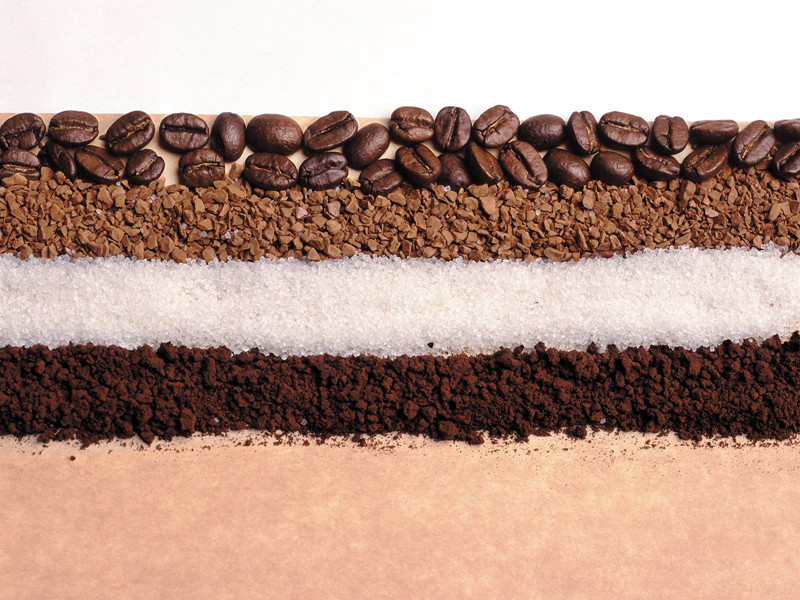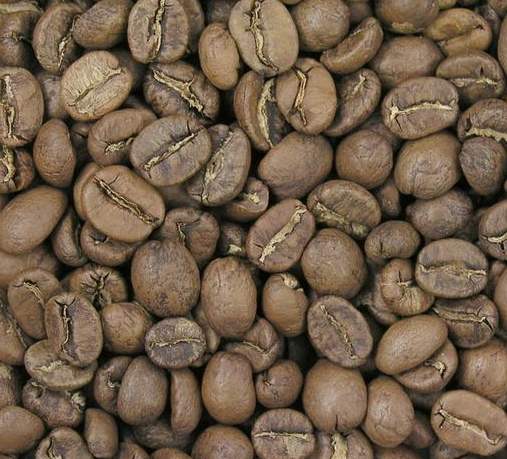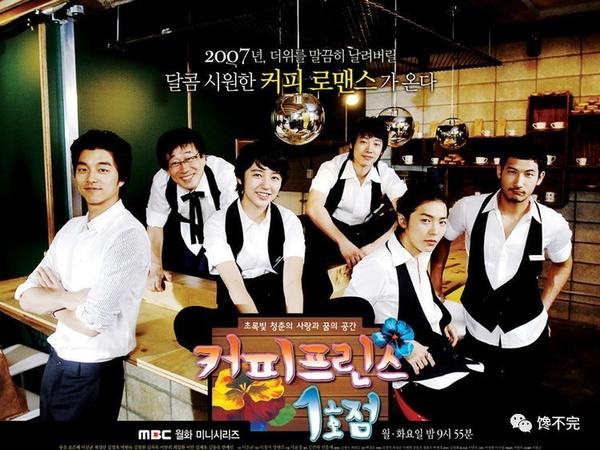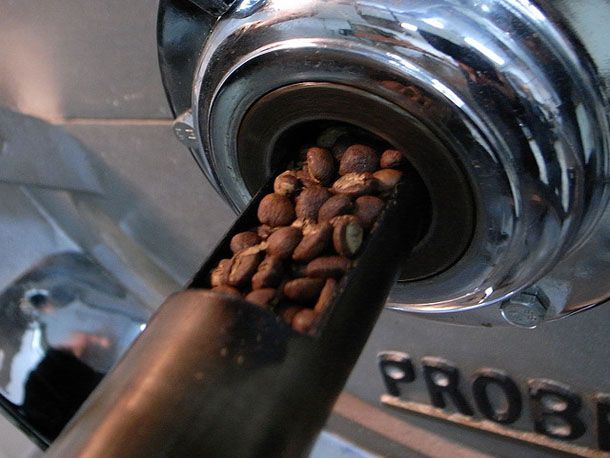[roasting knowledge] Coffee roasting apparatus types and roasting degree Coffee Roasting nouns
Coffee roasting Coffee Roasting
Coffee is popular mainly because of the aroma formed after roasting and the taste when drinking. The raw coffee bean itself has no special taste. Roasting completely changes and reorganizes the substances inside the raw bean to form a new structure, thus bringing out the mellow flavor of the coffee.

Baking tools, roasters, are divided into three types: direct fire, semi-hot air direct fire and hot air. At present, the latter two are the mainstream.
Direct fire: the earliest baking tool used by human beings. Disadvantages: slow heat conduction of iron; long baking time; waste of hot gas; raw beans contact with the drum wall for too long, easy to be scorched, resulting in bitterness and scorching taste; debris in and out of the tube attached to the surface of coffee beans will make the flavor turbid.
Semi-hot air direct type: improved and manufactured by Van Gupen, a German from 1870 to 1920. In 1907, the German Perfect roaster began to use this concept, using gas heating and a fan to bring half of the hot air into the drum and half to the outer heating drum. So far, the German Probat drum roaster is famous all over the world. In addition, Diedrich of Idaho took the lead in using gas-activated infrared heat source (Gas-Infrared) in 1987 to make temperature control more accurate and become the first brand in North America.
Semi-hot air direct type, directly heat the drum with fire source, and bring hot air to the drum at the same time, increase the heating speed, and blow away the debris, so a balanced and clean coffee bean is produced.
Hot air, the pioneer of the 20th century, uses hot air to bake coffee beans to improve roasting efficiency. In 1934, the Thermonro roaster (Jabez Burns Thermalo), a large hot air roaster, was made by the Bourne Company in the United States.
A flow-bed roaster (Fluid-Bed Roaster) blows raw beans with hot air and makes them fly up and down. In 1976, Michael, an American. Michael Sivetz designed a flow-bed roaster. Eon, a well-known Australian coffee expert. Ian Bersten also designed and manufactured fluidized bed roasters. When using this roaster, the coffee beans fall after being blown to the high point and are roasted by hot air again, which can roast the coffee beans evenly. However, the lack of metal drum smoldering, some people think that the lack of a taste.
Coffee roasting is a process of high temperature decomposition (Pyrolysis), which completely changes the substance inside the raw bean, produces new compounds, and recombines to form aroma and mellow flavor. This effect only occurs at high temperatures.
In fact, in the coffee processing process, baking is the most difficult step, it is a kind of science, but also an art. The baking process is divided into three stages:
Dehydration, in the early stage of baking, raw beans begin to absorb heat, and the internal water gradually evaporates. At this time, the color gradually changed from cyan to yellow or light brown, the silver skin began to fall off, and a faint smell of grass could be smelled. The main function of this stage is to remove moisture, accounting for about half of the baking time. Because water is a good conductor of heat transfer, it helps to bake the internal substance of coffee beans. Therefore, although the aim is to remove water, the baker will make good use of the temperature of the water and control it so that it will not evaporate too quickly.
Decompose at high temperature and bake to about 160 degrees, the water inside the bean will evaporate into gas and begin to remove the outside of the coffee bean. At this time, the interior of raw beans changed from endothermic (Endothermic) to exothermic (Exdothermic), the first burst sound appeared. After the first burst, it turns to endothermic, and the internal pressure of the coffee bean is extremely high, up to 25 atmospheric pressure. Heat and pressure begin to deconstruct the original tissue to form new compounds that create the taste and taste of coffee. When it reaches about 190 degrees, the conversion between endothermic and exothermic occurs again. Of course, high temperature cracking continues to occur, coffee beans from brown to dark brown, gradually into the stage of heavy roasting.
Quenching, the coffee should be cooled immediately after roasting, quickly stop the high temperature cracking and lock the flavor. Otherwise, the high temperature in the beans continues to work and will burn off the aromatic substances. There are two cooling methods, one is air-cooled, the other is water-cooled. The air-cooled type is slow, but clean and non-polluting, it can retain the aroma of coffee, so it is used for fine coffee. Water-cooled coffee beans are sprayed with a layer of water mist, causing the temperature to drop rapidly, requiring precise calculation, and increasing the weight of roasted coffee beans, commonly used in commercial coffee roasting.
Burst sound, raw beans from endothermic to exothermic, the internal substances out of the body, will form an obvious sound. The first is louder, crisp and scattered, and the second is quiet, meticulous and concentrated. Because of the high correlation between bursting sound and temperature, it can fully represent the baking temperature, which is an important basis for bakers to judge the baking degree.
The changes caused by baking are very complex, and although scientists continue to study and analyze them, they are still unable to get a full picture. There are roughly the following changes:
Weightlessness: the moisture content is reduced from about 13% to 1%, and the weightlessness is about 12% to 21%. The higher the baking degree, the more weightlessness.
Volume expansion: after baking, the volume of coffee beans will increase by more than 60%.
Pore enlargement: the cell wall of raw bean is hard and the cell is empty, so it is not easy to deteriorate. But after baking, the cell wall becomes fragile and the pores are enlarged, making it easy to lose internal material.
Formation of carbon dioxide: high temperature decomposition causes the carbohydrates inside the coffee bean to decompose and combine with other substances to form a large amount of carbon dioxide, which resides inside the coffee bean.
Change the organizational structure: after baking, carbohydrates dropped sharply from 58.9% to 38.3%, and acids (fatty acids, tannins, chloric acid, etc.) decreased from 8.0% to 4.9%. Under the action of high temperature pyrolysis, these substances are reorganized and transformed into caramel, carbon dioxide and some volatile substances. Among them, caramel accounts for 25% of the quality of roasted beans, forming the sweet taste of coffee. Fat accounts for 16.2% of raw beans and increases to 17% after baking, which is the source of mellow taste and consistency. There is little change in caffeine content. The bitterness of heavy-roasted coffee is not due to more caffeine.

Baking degree, Pacific region differentiation method:
Light Roast (light baking): it also has the smell of grass, no aroma and mellow taste.
Cinnamon Roast (cinnamon baking): coffee beans turn cinnamon
Medium Roast (medium baking): has a strong sour taste.
City Roast (High Color Baking): sour, bitter and sweet begin to strike a balance.
City + Roast (city baking): baked to the first burst, just about to enter the second burst.
Full City Roast (city-wide roasting): roasting until the second burst is in progress, is a favorite of select coffee roasters.
French Roast (French baking): very bitter.
Italian Roast (Italian roasting): the raw material of Italian espresso.
The American Fine Coffee Association (SCAA) judges and analyzes the color of coffee and the degree of caramel coking by Elon instrument. Set black to 0 and white to 100, divided into 8 equal parts, representing 8 baking levels.
Boutique coffee is different from commercial coffee in roasting:
The baking method is determined according to the properties of coffee beans (moisture content, hardness, year, and tested by sample cup)
Small amount of baking
The baker looks after the whole process during the baking process (pay attention to the change of temperature and time, listen to the popping sound and observe the change of color and luster)
Immediately after baking (Deliver at The Same Day Of Roasting).
Important Notice :
前街咖啡 FrontStreet Coffee has moved to new addredd:
FrontStreet Coffee Address: 315,Donghua East Road,GuangZhou
Tel:020 38364473
- Prev

Coffee and Prejudice-- on Coffee Culture in Korea
Professional baristas Please follow the Coffee Workshop (official Wechat account cafe_style) Coffee, one of the three drinks in the world, is made from roasted coffee beans. Together with cocoa and tea, they are the most popular drinks in the world. The word coffee comes from the Greek word Kaweh, which means strength and enthusiasm. As an important drink for Europeans, it has been integrated with life style.
- Next

What baking degree do you choose? The deeper the baking, the stronger the bitterness; the lighter the baking, the more sour.
Every coffee bean contains fragrance, sour taste, sweetness and bitterness. How to release it incisively and vividly depends on the skill of baking. The process and stage characteristics of coffee roasting the flavor of coffee not only depends on the variety of coffee, roasting is also a decisive factor. Basically, the roasting of coffee is a kind of high-temperature coking, which completely changes the substance inside the raw bean and produces new compounds.
Related
- How did the Salvadoran coffee industry develop in Central America?
- What exactly does the golden cup extraction of coffee mean?
- The Origin of Coffee flower
- [2023 Starbucks World Earth Day] there are more meaningful things besides free Starbucks coffee!
- What kind of coffee is there in Spain? 9 Flavors of Spanish Coffee
- Aromatic African coffee| Kenya's coffee culture and historical production area
- Liberica Coffee Bean knowledge: the characteristics of Liberian Coffee beans of the three original species of Coffee beans
- The origin and formula of Spanish latte introduces the taste characteristics of Bombon coffee in Valencia, Spain.
- How to adjust the solution of over-extracted coffee
- What is the tasting period of coffee beans? What is the period of coffee and beans? How should coffee wake up and raise beans?

